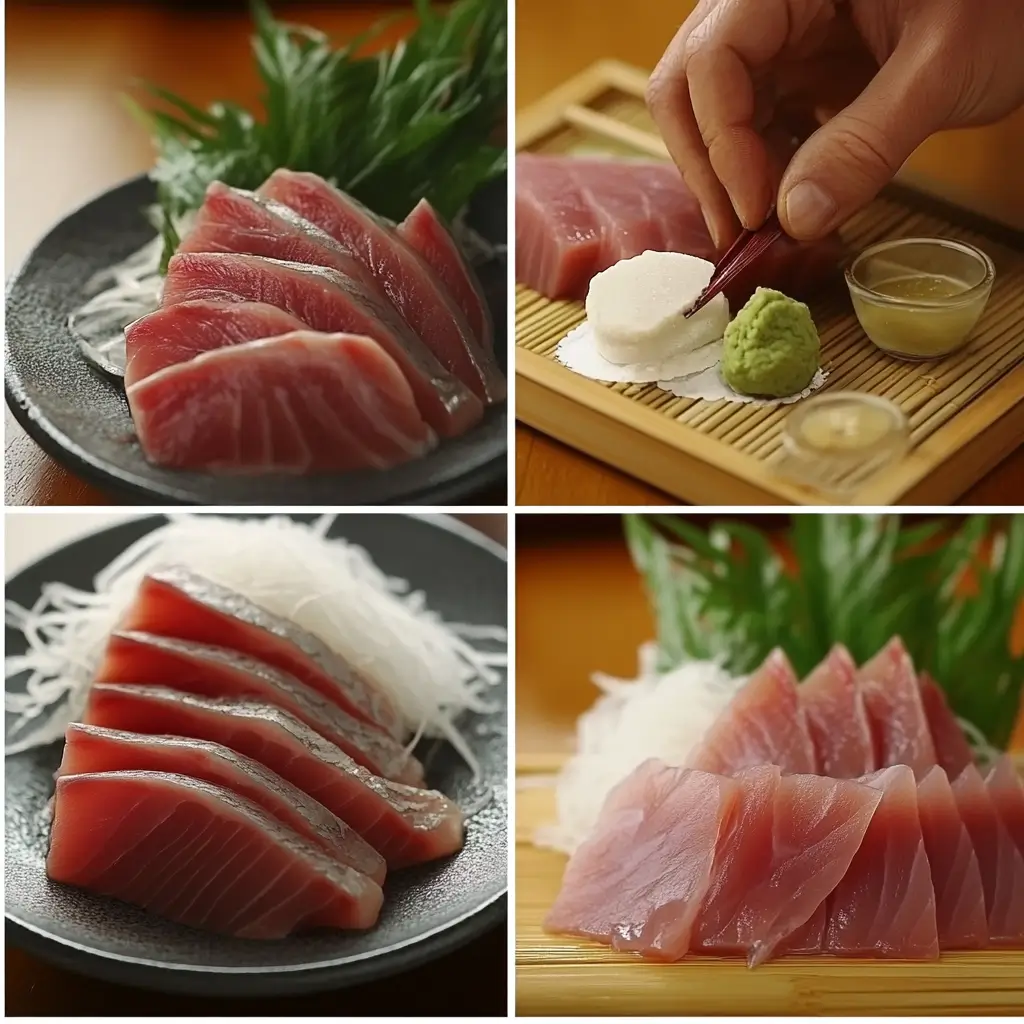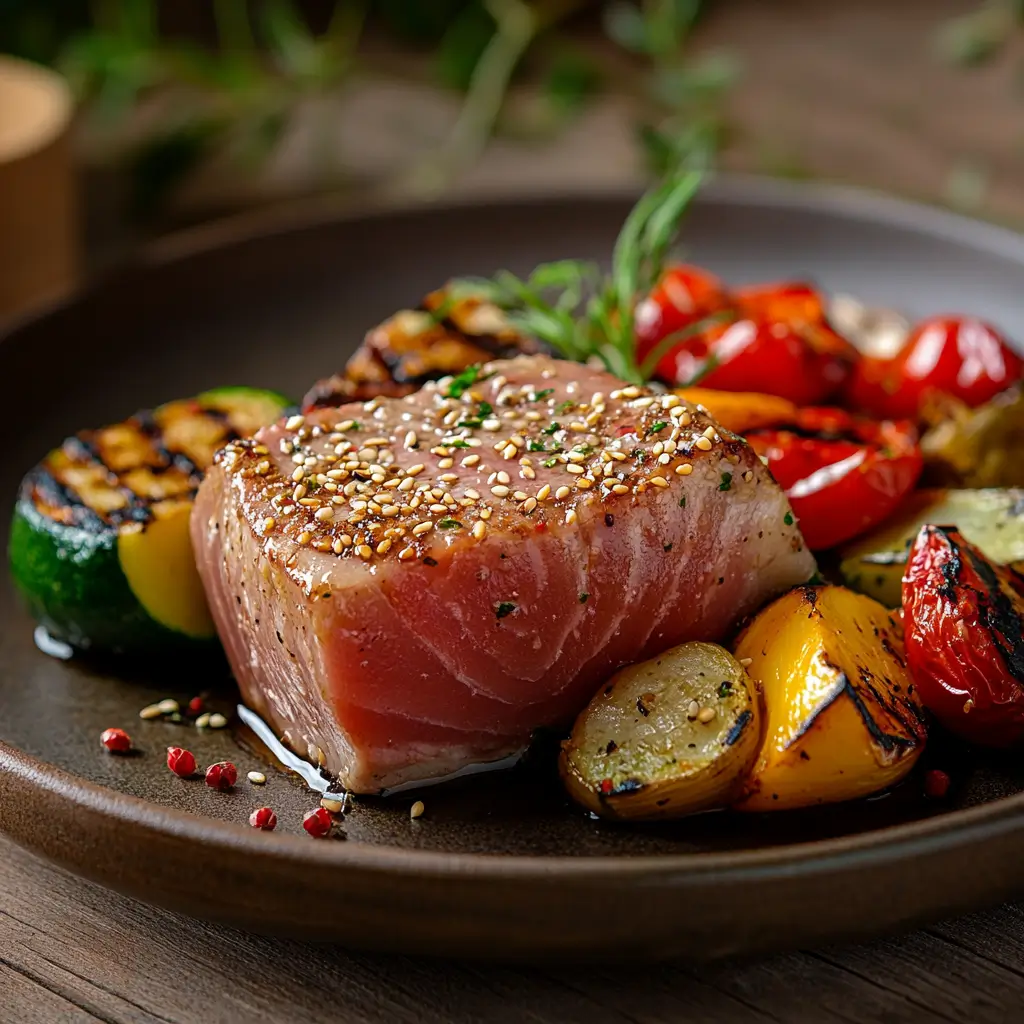When it comes to seafood, bluefin tuna takes center stage for its luxurious texture, rich flavor, and versatility in the kitchen. Whether you’re a culinary connoisseur or someone looking to experiment with seafood, this guide will walk you through the world of bluefin tuna, from understanding what makes it special to mastering the perfect bluefin tuna recipe. Along the way, you’ll learn how to select the best cuts, pair dishes with complementary sides, and even address common concerns about sustainability. Dive in and discover how to create restaurant-quality meals in your own kitchen!
A Deep Dive into Bluefin Tuna
What Makes Bluefin Tuna Unique?
Bluefin tuna, a prized fish in the culinary world, is revered for its marbled flesh and deep, meaty flavor. Found in the Atlantic and Pacific Oceans, these large fish are often the star of sushi menus and high-end restaurants. They can be prepared raw, grilled, seared, or baked, making them an incredibly versatile ingredient.
What sets bluefin tuna apart from other types of tuna is its buttery texture and high-fat content, particularly in the belly cut known as otoro. This delicacy has earned a spot on gourmet tables worldwide.
Nutritional Profile of Bluefin Tuna
Not only does bluefin tuna tantalize your taste buds, but it’s also a powerhouse of nutrients. Rich in omega-3 fatty acids, protein, and essential vitamins like B12 and D, it’s a health-conscious choice for seafood lovers. Eating bluefin tuna supports heart health, reduces inflammation, and provides energy for active lifestyles.
However, moderation is key. Due to its higher position on the food chain, bluefin tuna may contain trace amounts of mercury. So, enjoy it occasionally to balance flavor and health benefits.
Sustainability and Ethical Considerations
In recent years, concerns about overfishing have raised questions about the sustainability of bluefin tuna. To enjoy this delicacy responsibly, opt for tuna sourced from certified fisheries, such as those approved by the Marine Stewardship Council (MSC). Choosing sustainably sourced tuna helps preserve marine ecosystems and ensures future generations can savor this culinary treasure.
By understanding the origins and impact of your food choices, you contribute to a healthier planet while indulging in exceptional bluefin tuna recipes.
Choosing and Handling Tuna Like a Pro

How to Choose Fresh Bluefin Tuna
Selecting the freshest bluefin tuna is the first step to creating a show-stopping bluefin tuna recipe. Always look for tuna with firm, moist flesh and a vibrant color. Whether you’re buying a whole fish or fillets, the flesh should be free of discoloration or dullness. If purchasing sushi-grade tuna, ensure it’s clearly labeled and sourced from a reputable supplier.
Another quick tip: trust your nose. Fresh tuna should have a clean, ocean-like scent. If it smells overly fishy, it’s best to pass. For added reassurance, ask the fishmonger when the tuna was caught and how it’s been stored.
Proper Storage Techniques
Once you’ve secured your fresh tuna, proper storage is essential to preserve its quality. For short-term storage, keep the tuna in the coldest part of your fridge, ideally at 32°F, wrapped tightly in plastic wrap and placed in an airtight container. If you’re planning to use the tuna later in the week, freezing is the way to go.
To freeze, wrap the fish in wax paper, then seal it in a freezer-safe bag, removing as much air as possible. This technique ensures your tuna retains its texture and flavor, making your future bluefin tuna recipes just as delightful.
Essential Tools for Preparation
Preparing bluefin tuna calls for a few must-have tools. A sharp chef’s knife or sashimi knife is vital for clean, precise cuts, especially if you’re making dishes like sashimi or tartare. A fish scaler and filleting knife can also come in handy if you’re working with whole fish.
Additionally, having a food-safe thermometer helps ensure perfectly cooked dishes. From grilling to searing, the right tools will elevate your cooking game and bring your bluefin tuna recipes to life.
Classic Bluefin Tuna Recipes
Grilled Bluefin Tuna Steaks
Nothing beats the simplicity of a well-prepared grilled bluefin tuna steak. This bluefin tuna recipe brings out the fish’s natural flavors with just a few key ingredients. Start by marinating the steaks in olive oil, lemon juice, garlic, and soy sauce for at least 30 minutes.
When grilling, preheat the grill to medium-high and cook the steaks for 2-3 minutes per side, depending on thickness. Aim for a medium-rare finish to maintain the tuna’s tender texture. Serve with a drizzle of fresh lemon juice and your favorite sides, such as roasted vegetables or a light salad.
Bluefin Tuna Sashimi
For those who appreciate raw preparations, bluefin tuna sashimi is a must-try. To create this elegant dish, you’ll need sushi-grade tuna, a sharp knife, and a steady hand. Slice the tuna into thin, even pieces, ensuring each cut showcases the vibrant color and buttery texture of the fish.
Presentation matters too. Arrange the slices on a chilled plate, garnished with shredded daikon, wasabi, and pickled ginger. Pair this dish with soy sauce for dipping, and you’ve got a classic bluefin tuna recipe that’s as pleasing to the eye as it is to the palate.
Innovative Bluefin Tuna Dishes
Bluefin Tuna Tartare
For a fresh twist on a classic, try preparing bluefin tuna tartare. This bluefin tuna recipe combines finely diced raw tuna with vibrant flavors, creating a dish that’s both elegant and easy to make. Begin by selecting sushi-grade bluefin tuna and dicing it into small, uniform pieces. In a bowl, mix the tuna with ingredients like finely chopped shallots, capers, a squeeze of lemon juice, and a drizzle of high-quality olive oil. Season with salt and pepper to taste.
To elevate the dish further, consider adding diced avocado or a touch of sesame oil for an Asian-inspired flair. Serve the tartare chilled, accompanied by toasted baguette slices or crispy wonton chips. This innovative take on bluefin tuna is sure to impress your guests and delight your palate.
Seared Bluefin Tuna with Sesame Crust
Another inventive way to enjoy bluefin tuna is by preparing seared tuna with a sesame crust. This bluefin tuna recipe offers a delightful contrast between the crispy exterior and the tender, rare center of the fish. Start by coating the tuna steaks with a mixture of black and white sesame seeds, pressing gently to ensure the seeds adhere well.
Heat a skillet over medium-high heat and add a small amount of neutral oil, such as canola or grapeseed oil. Once the pan is hot, sear the tuna steaks for about 1-2 minutes on each side, depending on thickness, until the sesame seeds are golden brown. The goal is to achieve a rare to medium-rare interior, preserving the tuna’s rich flavor and tender texture.
Slice the seared tuna against the grain into thin pieces and serve atop a bed of mixed greens or alongside a light soy-ginger dipping sauce. This dish not only showcases the versatility of bluefin tuna but also introduces a delightful fusion of textures and flavors.
Pairing Bluefin Tuna with Sides and Beverages
Complementary Side Dishes
Choosing the right side dishes can elevate your bluefin tuna recipe to new heights. Light, refreshing sides often pair best with the rich flavor of bluefin tuna. Consider serving a crisp arugula salad with a citrus vinaigrette, or perhaps steamed asparagus drizzled with lemon-infused olive oil. Quinoa or couscous salads with fresh herbs and diced vegetables also make excellent accompaniments, providing a balanced and satisfying meal.
Wine and Sake Pairings
Selecting the appropriate beverage to accompany your bluefin tuna dish enhances the dining experience. For grilled or seared tuna, a light to medium-bodied red wine, such as Pinot Noir, complements the meatiness of the fish without overpowering it. If you prefer white wine, a chilled Sauvignon Blanc or a dry Riesling offers a refreshing contrast to the rich flavors of the tuna.
When enjoying bluefin tuna sashimi or tartare, consider pairing it with a premium sake. A Junmai Daiginjo sake, known for its delicate aroma and clean finish, harmonizes beautifully with the subtle flavors of raw tuna, enhancing each bite.
Crafting the Perfect Sauce for Bluefin Tuna
A well-chosen sauce can elevate your bluefin tuna recipe from simple to sensational. For grilled tuna steaks, a tangy chimichurri or a zesty lemon-caper sauce adds brightness and depth. When serving seared tuna with a sesame crust, a soy-ginger dipping sauce or a wasabi-infused aioli provides a delightful kick that complements the dish’s flavors.
Experimenting with different sauces allows you to tailor each bluefin tuna dish to your personal taste, creating a memorable dining experience every time.
Frequently Asked Questions about Bluefin Tuna Recipes
What is the best way to cook bluefin tuna?
The best way to cook bluefin tuna depends on your preferences, but searing is one of the most popular methods. A quick, high-heat sear locks in the natural flavors and preserves the buttery texture of the fish. Season the tuna lightly with salt, pepper, or a sesame seed crust, then sear for 1-2 minutes per side in a hot pan with oil. For those who enjoy raw preparations, bluefin tuna also shines in sashimi, tartare, or poke bowls.
What’s the best way to eat bluefin tuna?
Bluefin tuna is incredibly versatile, but its best enjoyed raw or lightly cooked to highlight its rich, melt-in-your-mouth texture. Sashimi, sushi, or carpaccio are excellent raw options. If you prefer it cooked, aim for a medium-rare finish through grilling, searing, or baking. Pairing the tuna with complementary sides, like citrusy salads or steamed vegetables, enhances its flavor.
What is the best oil to sear tuna in?
For searing tuna, choose oils with high smoke points, such as avocado oil, grapeseed oil, or canola oil. These oils can handle the high heat needed to create a golden crust without burning or overpowering the fish’s delicate taste. Lightly coat the pan to prevent sticking while ensuring the tuna cooks evenly.
Why is bluefin tuna meat so expensive?
Bluefin tuna’s price is driven by its demand and rarity. Prized for its high-fat content, especially in cuts like otoro (the fatty belly), bluefin tuna is a delicacy in the sushi world. Overfishing and limited supply further increase its cost. Sustainable practices aim to balance demand with conservation to preserve bluefin tuna populations.
What seasonings are good on tuna?
Tuna pairs well with a variety of seasonings. Simple options like sea salt, black pepper, and garlic let the fish’s natural flavor shine. For a bolder taste, try a soy-ginger marinade, lemon-pepper seasoning, or a crust of crushed sesame seeds. Herbs like dill or parsley can also add a fresh touch to your dish.
Does bluefin tuna taste different?
Yes, bluefin tuna has a distinct taste compared to other tuna varieties. It offers a richer, buttery flavor and a more tender texture, thanks to its higher fat content. These qualities make bluefin tuna a favorite for raw dishes and high-end recipes. Its flavor is more intense than albacore or yellowfin tuna, elevating any dish it’s featured in.

